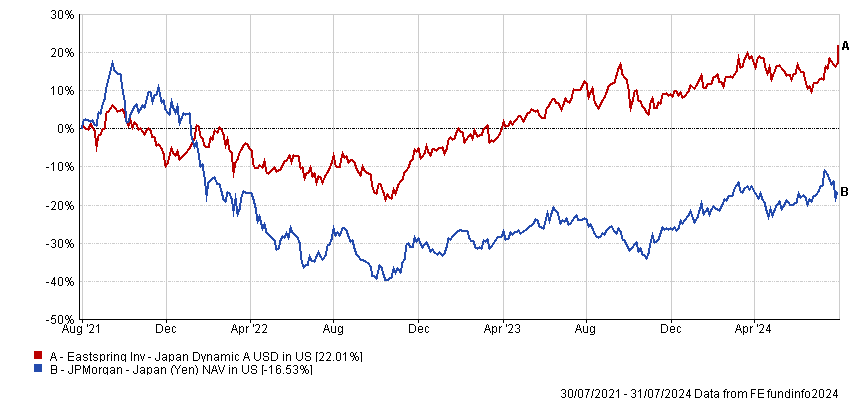After years of being ignored by international investors, the Japanese equity market has enjoyed a renaissance. Economic resilience, corporate governance reforms, and buoyant corporate profits boosted by a weak yen, as well as a rapid retreat from China, have spurred asset managers to raise their allocations to Japanese banks and heavyweight exporters.
The MSCI Japan was up 20.77% in US dollar terms in 2023 (29% in yen) and has added another 9.29% in US dollar terms (16.34% in yen) so far this year, according to FE fundinfo.
However, some of the enthusiasm for the market has subsided, even before the Bank of Japan raised interest rates 0.25% earlier this week to stem the slide of the yen. Higher rates could arrest the more positive trend for consumer spending fueled by recent pay raises, and also reduce the competitiveness of the country’s major exporters.
Nevertheless, improving corporate governance translated into better shareholder returns, a generally improving macroeconomic environment and the fact that Japanese equities still remain an underinvested asset class should continue to support the market.
Indeed, despite the recent hype, the average global equity fund has less than 5% of its assets allocated to Japanese equities, according to FE fundinfo data, while Japan’s weighting in the MSCI World index is 6%.

Against this backdrop, FSA asked Samuel Lo, associate director, manager research at Morningstar (pictured), to consider Japan equity strategies, and he chose the Eastspring Inv Japan Dynamic A fund (LU0560541111) and the JPMorgan Japan (Yen) (acc) fund (HK0000055670).
| Eastspring | JP Morgan | |
| Size | $2.77bn | $400m |
| Inception | 2006 | 1969 |
| Managers | Ivailo Dikov | Nicholas Weindling, Miyako Urabe, Shoichi Mizusawa |
| Three-year cumulative return | 22.01% | -16.53% |
| Three-year annualised return | 5.15% | -6.46% |
| Three-year annualised alpha | 4.76 | -6.68 |
| Three-year annualised volatility | 15.57% | 21.80% |
| Three-year information ratio | 0.43 | -0.86 |
| FE Crown fund rating | **** | * |
| Morningstar rating | *** | *** |
| Morningstar medal rating | Neutral | Silver |
| OCF (retail share class) | 1.75% | 1.66% |
Investment Approach
Although both strategies have concentrated, conviction-driven portfolios, the Eastspring Japan Dynamic and JPMorgan Japan strategies are very different, according to Morningstar’s Samuel Lo.
The Eastspring strategy follows a value approach. It seeks to invest in companies trading below at least one standard deviation on a price/earnings, price/book or dividend yield basis, relative to the past and to the market. Broker sentiments and earnings revisions are also analysed to help identify contrarian ideas.
The JPMorgan strategy follows a quality-growth approach. The fund management team looks for companies that can generate strong shareholder returns, have durable competitive advantages, and can allocate capital effectively.
“It focuses on the team’s highest conviction ideas and is often willing to pay high multiples for them. The portfolio has a higher expected growth and return-on-equity than the TOPIX benchmark, although its valuation is also higher,” said Lo.
The JPMorgan strategy owns 50-60 stocks, while the Eastspring strategy owns 30-50 stocks, so they are both concentrated portfolios, but the different focus of their strategies means different outcomes.
“As expected, the JPMorgan strategy has a greater exposure to the technology sector, where the portfolio manager has tended to find investment opportunities that fit his quality-growth approach,” said Lo.
“Meanwhile, the Eastspring strategy has greater exposure to sectors that are typically considered value-oriented, such as financials, real estate and materials,” he added.
Fund characteristics
Sector allocation:
| Eastspring | allocation | JP Morgan | allocation |
| Industrials | 23.65 | Electric appliances | 23.2% |
| Consumer discretionary | 17.4% | Others | 12.8% |
| Materials | 16.6% | Chemicals | 10.7% |
| Financials | 13.1% | Information & Communication | 9.8% |
| IT | 10.9% | Other products | 8.2% |
| Healthcare | 6.5% | Services | 7.7% |
| Real estate | 6.2% | Wholesale trad | 6.9% |
| Consumer staples | 4.3% | Insurance | 6.3% |
| Cash | 1.5% | Precision instruments | 5.1% |
| Transport equipment | 4.7% | ||
| Retail trade | 3.6% | ||
| Cash | 1.0% |
Top 10 holdings:
| Eastspring | allocation | JP Morgan | allocation |
| Ricoh | 6.0% | Hitachi | 6.9% |
| Panasonic Holdings | 5.8% | Tokio Marine Holdings | 5.9% |
| Takeda Pharmaceutical | 5.6% | Keyence | 5.8% |
| Sumitomo Mitsui Financial | 5.4% | Asics | 5.6% |
| Daito Trust Construction | 5.1% | ITOCHU | 5.3% |
| East Japan Railway | 4.5% | Shin-Etsu Chemical | 4.6% |
| Resona Holdings | 4.0% | Tokyo Electron | 4.5% |
| Sumitomo Chemical | 3.9% | SoftBank Group | 4.3% |
| Krin Holdings | 3.5% | HOYA | 3.8% |
| Nissan Motor | 3.1% | Recruit Holdings | 3.3% |
Performance

Given their contrasting investment style, the two strategies are expected to perform very differently depending on the market environment.
“The JPMorgan fund is expected to do better when growth stocks outperform, while the Eastspring fund would very likely do better when value stocks are in favour,” said Lo.
Lo thinks this is best illustrated by their performance over the past few years, “during which the Japanese stock market has seen a dramatic style rotation in terms of market leadership”.
Between 2017-2020, when growth stocks drove the market, the JPMorgan fund ranked in the top decile among peers, while the Eastspring fund ranked in the bottom decile. Later, when value stocks were in favour during 2021-2023, the Eastspring fund landed in the top decile while the JPMorgan fund was in the bottom decile.
“That said, we expect these stylistic effects to even out across a full market cycle,” said Lo. “Given that both strategies follow bottom-up, fundamental-driven approaches, their performance should depend on the success of the investment team’s stock picks over the long run.”
As already noted, the two strategies follow conviction-driven approaches and have concentrated portfolios, and they are both significantly more volatile than the TOPIX Index.
“Due to their strong stylistic orientations, their relative performance versus their peers and the index can also show large deviations,” Lo said.
Of the two strategies, Lo expects the Eastspring fund to be more volatile than the JPMorgan fund, as the former has a slightly more concentrated portfolio. It also tends to sport sizable exposure to certain subsectors, such as banks, carmakers, and heavy industries, within which “the stocks are highly correlated, which potentially reduces diversification and increases the strategy’s volatility,” according to Lo.
Manager Review
The Eastspring strategy is managed by Ivailo Dikov, who has around twenty years of Japanese equities experience. He joined the team in 2013, although he only took over this strategy in 2022. He draws from a five-member Japan equity team based in Singapore.
“The team is experienced and stable, although it is relatively compact,” said Lo.
The JPMorgan strategy is managed by lead manager Nicholas Weindling, who also has two decades of investment experience in Japanese equities. He has managed this strategy since 2007 and has “delivered an impressive long-term track record over his tenure,” said Lo.
He is supported by comanagers Shoichi Mizusawa and Miyako Urabe, and together they are part of a 24-strong Tokyo-based investment team. “The team is experienced and stable, and it is one of the largest among Japanese equity peers,” Lo said.
Fees
Lo has no concerns about the fees charged by the two strategies. The JPMorgan Japan (Yen) (acc) has an ongoing charge of 1.66% a, the Eastspring Inv Japan Dynamic A has an ongoing charge of 1.75%.
Conclusion
“We have a stronger conviction on the JPMorgan strategy,” said Lo.
The JPMorgan Japan (Yen) acc (HK0000055670) earns a Morningstar medalist rating of silver, underpinned by a high people pillar rating and an above average process pillar rating. Meanwhile, Eastspring Inv Japan Dynamic A (LU0560541111) is neutral-rated, with both people and process pillar ratings at average.
“We also favour the JPMorgan strategy for its capable and long-tenured lead manager Nicholas Weindling, its well-resourced supporting team, and the robust and time-tested investment process,” Lo said.
However, “investors should be aware that both strategies can sport high volatility and, as such, both of the strategies would be more suitable for investors with a long investment horizon to weather short-term volatility or headwinds,” he concluded.

















